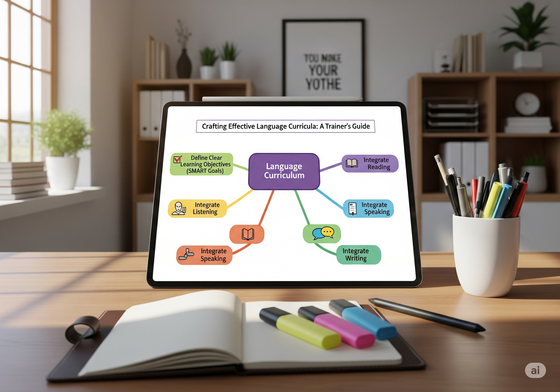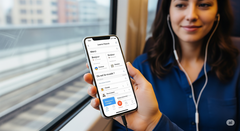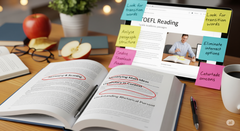Designing Impactful Language Programs for Optimal Learning
By Admin | Date: August 22, 2025 | Category: Education, Trainer Tips, Curriculum Design | Reading Duration: 10 min

A well-designed language curriculum is the backbone of successful learning. For language trainers, this means more than just following a textbook; it involves creating a dynamic, engaging, and results-oriented roadmap that genuinely caters to the diverse needs and learning styles of students. At Wissens World, we believe an effective curriculum is both a science and an art. This guide, drawing from the Wissens World trainer's guide, offers best practices to help you craft lesson plans that maximize student participation and lead to measurable language proficiency.
1. Define Clear Learning Objectives (SMART Goals)
Every curriculum and lesson plan should begin with clear learning objectives. What should students be able to do after a lesson, a unit, or the entire course? Use the SMART framework:
- Specific: What exactly will be learned?
- Measurable: How will you know if it's learned?
- Achievable: Is it realistic given the time and resources?
- Relevant: Does it align with student needs and overall course goals?
- Time-bound: When should the learning be achieved?
For example, instead of "Students will learn German," aim for "Students will be able to introduce themselves and ask basic personal questions in German by the end of Week 2."
2. Know Your Audience: Diverse Learning Styles
Students learn in different ways (visual, auditory, reading/writing, kinesthetic). A truly effective curriculum accommodates all.
- Visual Learners: Use images, videos, mind maps, and infographics.
- Auditory Learners: Incorporate dialogues, podcasts, songs, and discussions.
- Reading/Writing Learners: Provide texts, written exercises, journals, and grammar explanations.
- Kinesthetic Learners: Include role-playing, movement-based games, and hands-on activities.
Varying your teaching methods ensures that every student has opportunities to engage and process information effectively.
3. Integrate All Four Language Skills
A balanced curriculum develops all four core skills: Reading, Writing, Listening, and Speaking. While some lessons might focus more on one skill, ensure that over the course of a unit, students get ample practice in all areas. For example, a lesson might involve:
- Listening to a dialogue, then discussing it (Speaking).
- Reading a short text related to the dialogue, then writing a summary (Reading, Writing).
- Playing a game that reinforces vocabulary from the dialogue (Speaking, Listening).
4. Design Authentic and Relevant Content
Make language learning relevant to real life.
- Real-world Materials: Use authentic materials like newspaper articles, songs, movie clips, menus, or travel brochures from the target language.
- Situational Dialogues: Create scenarios that students might actually encounter (e.g., ordering food, asking for directions, giving personal information).
- Cultural Context: Weave in cultural insights and discussions to make the language more meaningful and engaging.
5. Incorporate Regular Assessment and Feedback
Assessment isn't just about grades; it's about guiding learning.
- Formative Assessment: Use quick quizzes, polls, short presentations, or informal questions during class to check understanding and adjust your teaching on the fly.
- Summative Assessment: Include end-of-unit tests, projects, or longer presentations to evaluate overall learning outcomes.
- Constructive Feedback: Provide timely, specific, and actionable feedback that helps students understand their mistakes and how to improve.
6. Plan for Flexibility and Adaptation
No curriculum is set in stone. Be prepared to adapt based on student progress, engagement, and unexpected challenges.
- Buffer Time: Build in extra time for activities or discussions that might take longer than expected.
- Alternative Activities: Have backup activities ready in case an original plan falls flat or students grasp a concept quickly.
- Student Input: Periodically ask for student feedback on what's working well and what could be improved.
Crafting an effective language curriculum is an ongoing process of creativity, planning, and responsiveness. By implementing these best practices, trainers can design learning experiences that are not only comprehensive and challenging but also deeply engaging, leading to confident and fluent language speakers.
⭐ Quick Takeaway ⭐
| Practice | Key Action | Benefit |
|---|---|---|
| 1. Define Objectives | Set SMART learning goals. | Provides clear direction and focus. |
| 2. Know Audience | Cater to diverse learning styles (VARK). | Engages all students effectively. |
| 3. Integrate Skills | Balance Reading, Writing, Listening, Speaking. | Develops holistic language proficiency. |
| 4. Authentic Content | Use real-world materials and scenarios. | Makes learning relevant and practical. |
| 5. Assess & Feedback | Regular formative & summative assessments. | Monitors progress and guides improvement. |
| 6. Be Flexible | Plan for adaptability; include buffer time. | Ensures responsiveness to student needs. |




